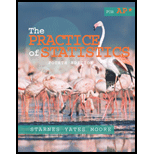
Concept explainers
(a)
To write:a sentence comparing S’s percentile among the national group
(a)
Answer to Problem 17E
S did better among all test takers than he did among the 50 boys at his school.
Explanation of Solution
Given:
1.5 million college-bound high school juniors take the test.
Mean score = 46.9
Standard deviation = 10.9
5.2% of test takers earned a score of 65.
Since 5.2% of test takers earned a score of 65 or higher on the Critical Reading test's 20 to 80 scale. In the national group, about
(b)
To calculate: S’s z-score
(b)
Answer to Problem 17E
The standardized score for S among the national group is greater than the standardized score among the 50 boys at his school.
Explanation of Solution
Calculation:
The standardized score for S among the national group is obtained below.
The standardized score for S among the 50 boys at his school is obtained below.
The standardized score for S among the national group is greater than the standardized score among the 50 boys at his school. This indicates that he did better among all test takers than he did among the 50 boys at his school.
Conclusion:
Therefore, the standardized score for S among the national group is greater than the standardized score among the 50 boys at his school.
Chapter 2 Solutions
The Practice of Statistics for AP - 4th Edition
Additional Math Textbook Solutions
Algebra and Trigonometry (6th Edition)
Calculus: Early Transcendentals (2nd Edition)
Elementary Statistics
Introductory Statistics
Calculus for Business, Economics, Life Sciences, and Social Sciences (14th Edition)
 MATLAB: An Introduction with ApplicationsStatisticsISBN:9781119256830Author:Amos GilatPublisher:John Wiley & Sons Inc
MATLAB: An Introduction with ApplicationsStatisticsISBN:9781119256830Author:Amos GilatPublisher:John Wiley & Sons Inc Probability and Statistics for Engineering and th...StatisticsISBN:9781305251809Author:Jay L. DevorePublisher:Cengage Learning
Probability and Statistics for Engineering and th...StatisticsISBN:9781305251809Author:Jay L. DevorePublisher:Cengage Learning Statistics for The Behavioral Sciences (MindTap C...StatisticsISBN:9781305504912Author:Frederick J Gravetter, Larry B. WallnauPublisher:Cengage Learning
Statistics for The Behavioral Sciences (MindTap C...StatisticsISBN:9781305504912Author:Frederick J Gravetter, Larry B. WallnauPublisher:Cengage Learning Elementary Statistics: Picturing the World (7th E...StatisticsISBN:9780134683416Author:Ron Larson, Betsy FarberPublisher:PEARSON
Elementary Statistics: Picturing the World (7th E...StatisticsISBN:9780134683416Author:Ron Larson, Betsy FarberPublisher:PEARSON The Basic Practice of StatisticsStatisticsISBN:9781319042578Author:David S. Moore, William I. Notz, Michael A. FlignerPublisher:W. H. Freeman
The Basic Practice of StatisticsStatisticsISBN:9781319042578Author:David S. Moore, William I. Notz, Michael A. FlignerPublisher:W. H. Freeman Introduction to the Practice of StatisticsStatisticsISBN:9781319013387Author:David S. Moore, George P. McCabe, Bruce A. CraigPublisher:W. H. Freeman
Introduction to the Practice of StatisticsStatisticsISBN:9781319013387Author:David S. Moore, George P. McCabe, Bruce A. CraigPublisher:W. H. Freeman





